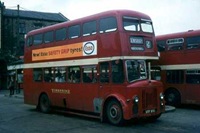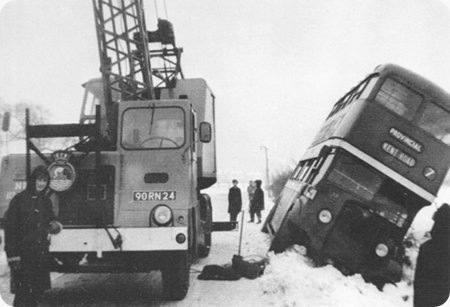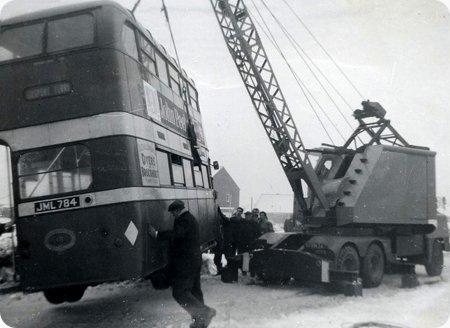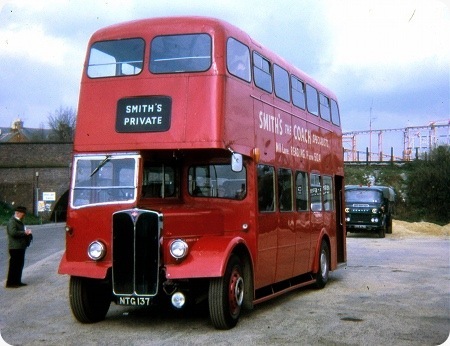Yorkshire Woollen District – Leyland Titan – UTF 930 – 773
Yorkshire Woollen District
1954
Leyland Titan PD2/20
MCW H34/29R
The above shot was sent to me by Bob Gell with the following comment:
There is correspondence under the Yorkshire Woollen District Tiger PS1 posting about this vehicle – I took the attached photo in July 1969 at Dewsbury Bus Station.
I’m intrigued by the total lack of opening windows on each side upstairs, with ventilation only from the two vents in the front windows – presumably part of its ‘spec’ as a demonstrator. I wonder if it was built around the same time as the Edinburgh lightweights, the ‘Monstrous mass of shivering tin’, as they were known in Edinburgh?
The vehicle was actually an ex Leyland Motors demonstrator and I think it was built to Edinburgh specification it does look very similar. I am not sure what year the vehicle entered service with Yorkshire Woollen District but my thanks to John Blackburn who informed me that it was renumbered 54 in 1967 and withdrawn in 1970 going to Norths of Sherburn in Elmet in 1971 and presumably scrapped. If you wish to read the comments on the Yorkshire Woollen District Tiger PS1 posting click here.
Photograph contributed by Bob Gell
06/02/11 – 09:12
This former Leyland demonstrator did indeed have an MCW body to Edinburgh specification hence the strip bell (see Tiger comments) It also had an Edinburgh blind layout. I only ever saw it once whizzing up Whitehall Road Leeds at a great rate of knots with its exhaust booming off the surrounding buildings
Chris Hough
06/02/11 – 09:12
With regards to Y.W.D. 773 [later 54] this was a standard Edinburgh Corporation PD2 that was taken from a batch that were being built for them. An Edinburgh Baille once described them as being monstrous pieces of shivering tin. Anyway I always liked it. The crews liked it too because of the Edinburgh style destination box it could show a lazy blind of the two ends of a route.
Philip Carlton
07/02/11 – 20:11
Edinburgh’s Titans may well have been monstrous masses of shivering tin but most of them gave up to 20 years service. Their grey and red interiors were still being used until the advent of low floor deckers in Edinburgh I well remember my first visit to Edinburgh in 1971 when every bus seemed to be one of the Titans. The other gems such as the Alexander bodied Guys just paled into insignificance alongside the Titans
Chris Hough
07/02/11 – 20:37
I had never noticed its lack of upper deck ventilation windows until now. Looking at views of its Edinburgh contemporaries I note that they all had two upper and two lower ventilators. Was the lack of upper deck ventilators on the demonstrator a one-off or was it a YWD alteration?
Paul Haywood
10/02/11 – 05:48
I worked for YWD at the time UTF 930 or 773 as it was known and loved was in service, this was the BEST vehicle on the fleet. As I said in another reply this vehicle was the most reliable vehicle we ever had!. It used to go out on duty and was forgotten until some one remembered it may need cleaning, a liner check, or greasing/oilchange The vehicle was fitted with Vacuum brakes and Leylands RP (Ratchet Paul) brake adjusters which worked perfectly (If maintained correctly) and only came in when it required a reline. Unlike modern day practice of relining an axle set we only relined one corner at a time, with NO problems!! The driver would fight over it!! And it made the most wonderful noise when accelerating (almost like a Ferrari!!!). I just wish someone had had the money to preserve it but alas it went to the big bus haven in Sherburn in Elmet, Norths Scrap Yard.(unless some one can tell me different!!)
Chris Bligh
10/02/11 – 09:07
Chris Hough’s comment on the Edinburgh "shivering masses of tin" took me back many years to when a temporary shortage of buses in Sheffield resulted in a batch of those splendid vehicles being sent south on loan. Visiting the Steel city with a friend one evening we took a random ride on one for the experience and were most impressed by its incredibly good condition. I don’t know the Sheffield routes at all really, but would I be right in thinking that it was on service 75 or 76 to Low Edges ?? The bus was full to capacity and on one very steep street in particular we were treated to one of the most masterly pieces of driving – starting off in first gear and going to full revs the driver changed beautifully into second without a click or a jerk of any kind – and the conductress was an immaculate efficient Caribbean lady with a cultured "BBC" accent and the politest of manners – a lovely journey to recall.
Chris Youhill
10/02/11 – 10:14
I wasn’t living in Sheffield during the "shortage" but still have family there and visit regularly. If it were a 76 Lowdedges then the steep hill would have been Woodseats Road. Had it been a 75 Bradway, it could also have been Meadowhead.
I was brought up in the Lowedges area of Greenhill which was originally serviced by the 38 (later by 42/53), the 75/75 originally serviced by the 59. The stop at the bottom of Meadowhead was a classic test of hill starting with a full bus with a crippling gradient. The 38 was basically an AEC route with Leyland input. The AECs posed no problems by the PD3s sorted the men from the boys with grinds, grauches and lurches! This stop was notorious and was subsequently moved back to a flat approach to Meadowhead, nearer Graves Park’s Woodseats entrance, to avoid the hill start.
David Oldfield
11/02/11 – 06:59
Thank you David for the information on those forbidding Sheffield hills – whichever was the one that I remember so well it was a most creditable performance by the driver – he must without doubt have been one of those chaps with a genuine interest in the job and a real pride in his work.
Chris Youhill
16/04/11 – 05:00
The reason they lasted so long in Edinburgh was the fact that the bodies were rebuilt every 6 years. The quoted phrase was – “They are ungainly, inelegant, monstrous masses of shivering tin. They are modern to the extent of becoming able to produce a perfect synchronization of rock `n` roll. As far as Edinburgh went the bodies were a disaster,with front and back domes breaking free and the odd staircase detaching itself from the top deck among the other numerous problems such as cracking the nearside chassis rail, which resulted in expensive and time consuming body off repairs. The Edinburgh cobbles did these bodies no favours.
Brian Melrose
02/01/14 – 17:24
Most deckers of PD2s and 3s suffered this complaint of broken chassis rails which when you think about it all the swaying with a full top load of passengers over 10 years or more did these buses no favours l hope this may answer your questions on this matter. I am a bus enthusiast and have been for the last 50 years or so.
JohnE
03/01/14 – 07:55
Sheffield had their own almost identical batch of 20 Weymann/ PD2/30 but with more ventilation. The bodies were a nadir – and most unworthy of the name Weymann. Later deliveries were to a higher standard – more like earlier Weymanns. Going back to Chris Y’s earlier comments; in retrospect, my memories of STD drivers in the PD2/PD3 era are that they were well trained and generally drove very well.
David Oldfield
 Vehicle reminder shot for this posting
Vehicle reminder shot for this posting
24/09/14 – 08:38
I congratulate all those who knows which bus is made by who, all I was interested in was getting from A to B; never trusted any of the service busses, there was never any guarantees I would finish with the same bus I started with!
From Frost Hill, I did Batley/Birks, Dewsbury/Cleckheaton, Halifax/Leeds, Dewsbury/Bradford, but that was a story of its own, Huddersfield/Leeds, Elland/Leeds including Rastrick, but by gum, I don’t know or remember anything about bus types, models or the likes, I just drove them, so God bless those who remember so much. To me, they were Leyland with a cab, Leyland Atlantean, Leyland air/auto, Guy bronze box and crash box, and that includes double and single deckers; but, does anyone remember the new coach we got at Frost Hill in 1968 that was all electric push button geared, now that was a coach worth taking to the footy matches, but I made sure I was last there and first out, especially when Leeds played at home!
Donald Campbell
25/09/14 – 16:11
What was a Guy Bronze box?
Was it anything to signify the H pattern being different for gear changes?
John Blackburn
26/09/14 – 05:41
The original Guy Arab of 1933 had a four speed sliding mesh (crash) gearbox with "right to left" upward gear selection positions, and this box was used in the wartime Arab utilities. Towards the end of 1945, Arabs were delivered with a new constant mesh gearbox which had conventional gear selector positions. I would think that Donald was unlikely to have experienced the old Guy crash gearbox.
Roger Cox
27/09/14 – 07:09
Roger.I had the pleasure of driving former Burton Corporation Guy Arab 111/Massey no 18 when first preserved and this also had the right to left gearbox. YWD also re-bodied many wartime Arabs so they could still have this gearbox.
Geoff S




